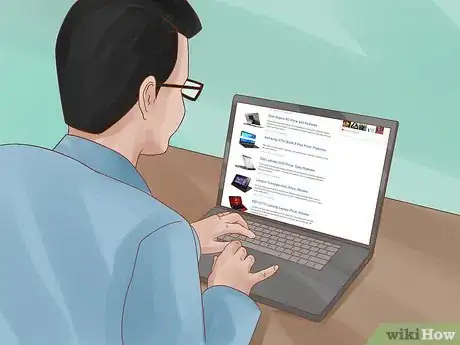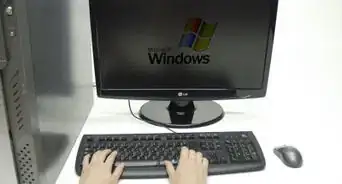This article was co-authored by Michael R. Lewis. Michael R. Lewis is a retired corporate executive, entrepreneur, and investment advisor in Texas. He has over 40 years of experience in business and finance, including as a Vice President for Blue Cross Blue Shield of Texas. He has a BBA in Industrial Management from the University of Texas at Austin.
There are 10 references cited in this article, which can be found at the bottom of the page.
This article has been viewed 43,847 times.
Laptop computers are a major part of the electronics market today. More and more people are going from the old, non-portable, desktop varieties to smaller and sleeker laptop designs that often include the same computing power in a more compact shell. But sometimes consumers face challenges in affordability for even the cheapest laptop computers. Computers are major appliances that can cost hundreds of dollars. However, some people have no credit history to rely on and no savings to fall back on when the time comes to purchase a new laptop. For those people who need to finance a laptop with no credit, a little research will help you figure out a way to get the laptop you need.
Steps
Financing a Laptop
-
1Find the laptop that best matches your budget. If you are able to locate a discounted laptop computer, you may get closer to your goal by slashing the amount of money that needs to be financed in the purchase.[1]
- Spend some time searching for a good deal. Look at stores online, newspaper advertisements, and in-store deals.
- Consider what features you actually need versus what you could eliminate as just a luxury.
-
2Look at informal lending options. In some cases, family members or others can help out, for example, when a student needs a computer for school but can't pay all of the money up front. Informal lending can often offer lower interest than a formal lender would accommodate, with less of the red tape that goes into a personal loan from a bank.
- Ask your parents or a close family member or friend if they’ll consider loaning you the money or purchasing the laptop for you.[2]
- Let them know what your plan is to pay them back, how you expect to come up with the money, and how long you think it will take you to repay the loan.
Advertisement -
3Consider a buyback laptop program. A buyback program can work for those who want the newest kinds of computers and devices but can't afford to pay for them up front. The idea is that you purchase an older laptop up front, and use it until you build up additional cash, and trade it in for a newer model.
- This can sometimes alleviate the obstacles from a poor credit score that prevent conventional financing for your computer purchase.
-
4Consider a "no credit check" laptop deal. Some companies are willing to finance laptops without doing a credit check. The borrower may need to pay additional money in the form of higher interest, and provide more of a down payment, but some of these deals can work out if you just need to finance a specific portion of a laptop purchase.
- Instead of checking your credit, these lenders usually have a few alternative requirements of their own. This can include things like being employed for at least six months, maintaining an active checking account for a period of time, and not overdrafting your account.[3]
Trying Rent-to-Own Options
-
1Evaluate rent-to-own options. A rent-to-own laptop process can help you finance the computer without a credit check. These types of programs are designed to help those who need financing but face challenges from conventional lenders because of their credit.
- Of course, if you go this route you’ll end up spending more money on the laptop due to financing charges and interest rates than you would if you purchased the laptop outright.
-
2Look into several different rent-to-own places. Different places will have different deals and different requirements. You should check out several places before you commit to a single one. This will help ensure you get the best deal possible concerning the price of the laptop, the interest rate, and any additional fees you might incur.
-
3Collect as large of a down payment as possible. It may not be possible to pay for the entire computer up front, but having a larger down payment can help with the kinds of problems that consumers encounter when they try to finance a laptop purchase without sufficient credit history or with a poor credit score.
Building Your Credit for Future Purchases
-
1Pay your bills on time. Keeping up-to-date on your payments is an important part of building a good credit history. Late payments are reported to the credit bureaus and will negatively impact your credit score. This could keep you from being able to purchase things you want in the future with credit.[6]
- This applies to all of your financial obligations, not just credit card payments. You should use also pay your other bills on time whenever possible – like your utility bills, phone bills, and any other loans you might have (car, mortgage, etc.).[7]
-
2Get a credit card. A good way to start building up your credit score is by getting a credit card. There are many different options for this, so even if you have been refused in the past you should still be able to find a type of credit card that works for you. Try one of the following options for credit cards[8] :
- Secured credit card – this kind of card is great for people with no credit because almost anyone can get approved for them. It is a card that is funded by cash deposit you made ahead of time so there is little risk for a lender and you’ll still get credit for positive payments.
- Student credit card – this kind of card is often easier to get because they are geared towards students who they already assume have little to no credit history. Unfortunately, they often have lower credit limits than other types of cards, but they also sometimes come with enticing promotional offers.
- Retail credit card – a retail credit card is a good credit-building option because it usually has a higher acceptance rate than a regular card. They can also offer promotional incentives to help you save money at their store. But these kinds of cards may also have lower credit limits than a normal card.
- Authorized user – being an authorized user on someone’s account means that you’ll have a card with your name on it for someone else’s credit account. So, you have access to the credit (and, therefore, the account holder’s payment history will positively affect yours), but you are not responsible for any of the payments. Ask your parents or another friend or family member who already has good credit if they’ll let you be an authorized user on their account.[9]
-
3Keep your balances low. Using your credit cards is important, but it’s also a good idea to not use them too much. Try to keep your balances low by paying them off every month (or as close to it as you can get).[10]
- Using 30% or less of your available credit looks good to potential lenders.
- If you max your credit cards out, this can appear to lenders as if you rely too much on your credit, which is not a good sign to them.
-
4Get a credit builder loan. These kinds of loans are low-risk (for your and the lender!) loans that you can get from most banks. They are usually for a small amount (not more than $1000) and the money is put in an interest-earning account while you make monthly payments toward this “loan.”[11]
- Once the amount is paid off, the funds are released to you plus the interest it accrued while it was being held by the bank.
- These kinds of loans are usually designed to be paid back within 6 to 18 months.
Warnings
- Remember that purchasing a laptop with any kind of credit, whether it’s a credit card or a rent-to-own option, will always cost you more money in the long run than buying it outright would.⧼thumbs_response⧽
References
- ↑ http://www.digitaltrends.com/computing/best-budget-laptops/#:uL6_jGtlYT3ANA
- ↑ http://www.moneyunder30.com/how-to-ask-your-parents-for-money
- ↑ https://www.xidax.com/no-credit-check-financing
- ↑ https://www.aarons.com/what-is-rent-to-own
- ↑ https://www.rentacenter.com/how-rac-works/faqs
- ↑ https://www.wellsfargo.com/financial-education/credit-management/build-credit/
- ↑ https://www.nerdwallet.com/blog/finance/how-to-build-credit/
- ↑ https://www.creditkarma.com/article/build-your-credit-from-scratch
- ↑ http://www.moneyunder30.com/best-build-credit-first-time































































